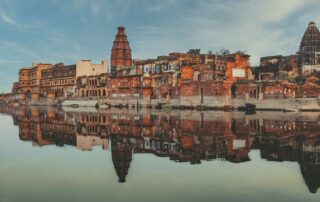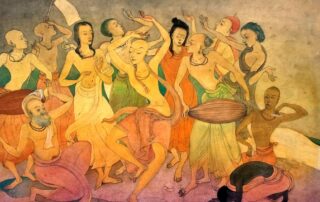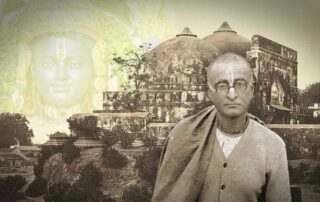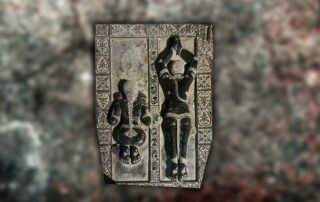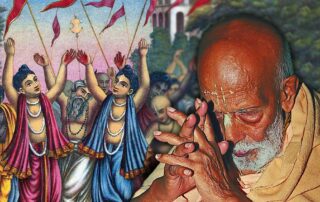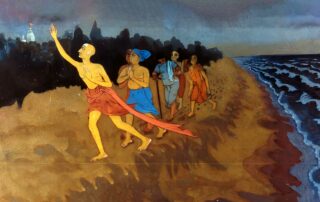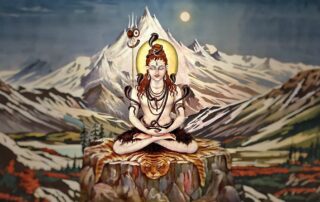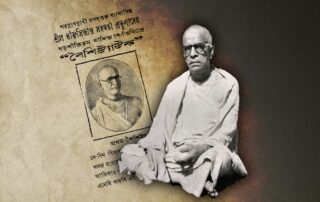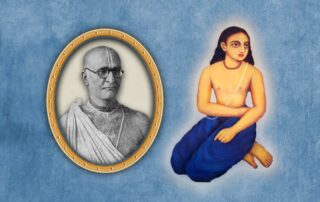“Krishna Talk” is a comprehensive source of in-depth articles on Gauḍiya Vaiṣṇava Siddhānta, History, and Culture. Founded by Swami B.G. Narasiṅgha Mahārāja in 2000, our collection of articles by past ācāryas and contemporary authors is updated weekly. Easily navigate the various categories to find the specific topic you’re interested in and dive deeper into the treasure-house of Gauḍiya Vaisnava siddhānta with these detailed and enlightening articles.
Pilgrimage with Swami Narasiṅgha – Part 7: Keśī Ghāṭa
Continuing with our pilgrimage series, this week Śrīla Narasiṅgha Mahārāja takes us to Keśī Ghāṭā where he tells us about Madhumaṅgala’s meeting with the Keśī demon, what Keśī represents, and how Śrīla Prabhupāda almost acquired Keśī Ghāṭa. Mahārāja also narrates his own experience. This article has been adapted from a number of talks and articles by Narasiṅgha Mahārāja.
Prema Dhāma Deva Stotram with the Narasiṅgha Sevaka Commentary – Verses 61-65
In verses 61 to 65 of 'Prema Dhāma Deva Stotram', Śrīla Śrīdhara Mahārāja narrates the pastime of Śrī Caitanya at Caṭaka Parvata In Purī and explains how the scriptures produced by Brahmā and Śiva are ultimately searching for the personality of Mahāprabhu who is merciful too all jīvas, no matter what their social position.
Prabhupāda Śrīla Sarasvatī Ṭhākura’s Visit to Ayodhyā
With the forthcoming observance of Śrī Rāma Navamī, we present 'Prabhupāda Śrīla Sarasvatī Ṭhākura’s Visit to Ayodhyā' written by Śrīla Bhaktisiddhānta Sarasvatī Ṭhākura Prabhupāda from The Gaudīyā magazine, Vol 3. Issue 21/ In December 1924, after visiting Benares and Prāyāga, Sarasvatī Ṭhākura visited the birth-site of Śrī Rāmācandra in Ayodhyā.
Śaraṇāgati – The Only Path to Auspiciousness
In this article, 'Śaraṇāgati - The Only Path to Auspiciousness', Dhīra Lalitā Dāsī analyses the process of śaraṇāgati (surrender) beginning with śraddhā (faith). She also discusses the role of śāstra and the Vaiṣṇava in connection with surrender.
Ātma Samīkṣā – The Value of Introspection
In this article, "Ātma Samīkṣā – The Value of Introspection" Kalki Dāsa highlights the importance of introspection in the life of a devotee and especially in relation to the worldly environment that surrounds us. He also explains how transcendental sound influences our capacity to introspect.
Svasti No Gaura-vidhur Dadhātu (May the Moon-like Gaura Bestow Auspiciousness)
This Bengali poem, ‘Svasti No Gaura-vidhur Dadhātu,’ (May the Moon-like Gaura Bestow Auspiciousness) written by Śrīla Bhakti Pramoda Purī Gosvāmī, was first published in 1965 in Caitanya Vāṇī magazine, Vol.5, Issue 1. In this composition, Śrīla Purī Mahārāja gives advice to the fallen jīvas to sincerely accept Mahāprabhu's gift of the Holy Name. This poem was translated into English by Sanātana Dāsa and Parameśvarī Devī Dāsī.
Prema Dhāma Deva Stotram with the Narasiṅgha Sevaka Commentary – Verses 56-60
In verses 56 to 60 of 'Prema Dhāma Deva Stotram', Śrīla Śrīdhara Mahārāja describes the various remarkable ecstatic transformations of Śrīman Mahāprabhu such as his kūrma-dharma (becoming like a turtle), as well as His pastime of running into the ocean at Cakra-tīrtha, mistaking it to be the Yamunā River.
Śiva-tattva – the Position of Lord Śiva
On the auspicious occasion of Mahā-Śivarātri, we present the following article which has been adapted from various talks that Śrīla B.R. Śrīdhara Deva Gosvāmī Mahārāja gave during the 1980s concerning śīva-tattva.
Vaiśiṣṭyāṣṭaka (Eight Stanzas of Significance)
We present this important Vyāsa Pūjā offering by Śrīla A.C. Bhaktivedānta Swami Prabhupāda on the 150th appearance anniversary of Śrīla Bhaktisiddhanta Sarasvatī Ṭhākura Prabhupāda. Vaiśiṣṭyāṣṭaka (‘Eight Stanzas of Significance’) was Śrīla Prabhupāda’s Vyāsa Pūjā offering written at the Vaṁśī-Gopāla Temple, on the 86th appearance day of Śrīla Sarasvatī Ṭhākura. It was first published in Śrī Gauḍīya Patrikā, Vol. 12. Issues 1 & 2 in April 1961. As our readers will see, many points that Prabhupāda addresses in this poem are as relevant today as they were when he wrote it sixty-three years ago.
A Lecture on Śrī Nityānanda Trayodaśī
This talk by Śrīla Bhaktisiddhānta Sarasvatī Ṭhākura Prabhupāda was given on the evening of Śrī Nityānanda Trayodaśī at the Yogapīṭha in Śrīdhāma Māyāpura on 5th February, 1936. It was first published in The Gauḍīya, Vol. 16, issue 39.



